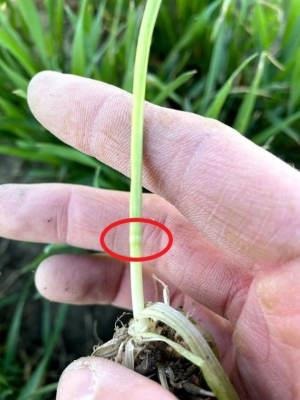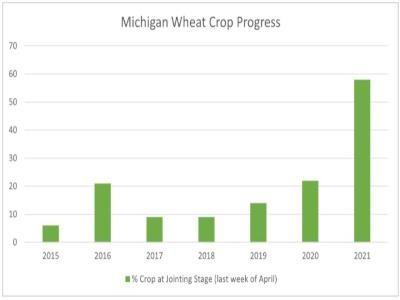By Ricardo Costa
This is the first time that over 50% of the crop in the state has reached Feekes 6 (GS6) stage by the end of April based on NASS's survey responses.

The first node indicates wheat has reached Feekes growth stage 6 (jointing).
While scouting your wheat fields this season, you might be under the impression that your wheat is growing faster than last year. Guess what? You are correct. According to the latest wheat watchers report from April 26, 2021, many watchers have reported wheat at or above the Feekes 6 growth stage (jointing). To give you some perspective, in Lenawee and Monroe counties in southeast Michigan, we found wheat at the jointing stage back on April 16.
The rate of development for wheat depends primarily on temperature. As for calendar date, the growth stage 6 usually occurs around May 1—give or take five days—in central Michigan, a few days earlier in southern Michigan, and a few days later in northern Michigan. The date of seeding also matters. Generally, wheat sown in September may reach growth stage 6 several days ahead of a crop seeded a month later.
We decided to dig deeper and compare the 2021 wheat crop progress with previous years. We checked the last week of every April Crop Progress & Condition Report from 2015 to 2021. As you can see in the graph below, this is the first time that over 50% of the crop in the state has reached Feekes 6 stage by the end of April based on the USDA National Agricultural Statics Service (NASS) survey responses.

Graph showing wheat crop progress by the end of April (2015 to 2021).
Why is this important? As former Michigan State University Extension wheat educator Martin Nagelkirk and I mentioned in “Wheat growth stage 6 signals game on!,” the most significant advantage to identifying growth stage 6 is that it is a valuable reference to gauge the timing of various production inputs or practices. Once growth stage 6 is reached, any micronutrient deficiency should already have been addressed, and the bulk of the fertilizer nitrogen should have been applied. In addition, herbicides including PowerFlex HL, Osprey and growth regulator products such as 2,4-D, dicamba, MCPA and Curtail should no longer be used.
Growth stage 6 is also helpful as a reminder that the cutoff for using some other crop protection products is only one to two weeks away (again, depending on air temperatures). Before the end of growth stage 7 (two nodes without the flag leaf tip being visible), applications of herbicides including Affinity, Harmony, Huskie, and Quelex, and the growth regulator Palisade, must be completed to avoid crop injury or an off-label application.
Also, don't forget that you need to start thinking about fungicide applications. Since the crop is progressing ahead of schedule, don't be caught off guard and be ready with fungicides. The crop may reach Feekes 9 (flag leaf fulling emerged) in a few warm days in the earliest parts of the state. If a significant level of foliar disease is present, consider a foliar fungicide to protect the flag leaf. When wheat reaches Feekes 10 growth stage (boot stage), do not apply fungicides containing strobilurin as this can sometimes lead to an increase in DON.
Last but not least, in a blink of an eye, wheat will reach the Feekes 10.5.1 growth stage (beginning flowering). By then, if scab risk factors are present, make fungicide application from the beginning of flowering until six days after the start of flowering. According to MSU plant pathologist Martin Chilvers, preference should be given to applying fungicides four days after the beginning of flowering as this results in the best scab reduction and DON suppression. Applying four to six days post-flowering also widens the protection window if an application was made at Feekes 9 to protect the flag leaf.
Essential wheat management practices based on the wheat growth stage are coming up in the next few weeks, so to be ready for timely herbicide and fungicide applications, scouting needs to be a priority.
Source : msu.edu